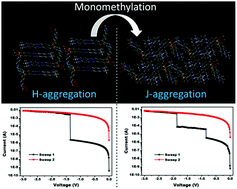Terminal amino monomethylation-triggered intermolecular H- to J-aggregations to realize tunable memory devices†
Abstract
Since the first report on a small-molecule-based ternary memory device, most of the subsequently designed small molecules guided by the “charge trap” mechanism can exhibit the corresponding multilevel memory behaviours. However, a few small molecules with distinct electron acceptors serving as shallow and deep charge traps cannot show the typical ternary memory property; this restricts the better understanding of the “charge trap” mechanism and limits the following design of novel multilevel memory materials. In this study, through monomethylation at the terminal amino group, two small molecules with similar molecular backbone and energy levels were designed to investigate the effect of the aggregation styles on the multilevel memory behaviours. This simple monomethylation strategy not only triggers the H- to J-aggregation in thin films, but also allows tuning of the device behaviour from traditional binary memory behaviour to ternary data storage behaviour. Most importantly, this study breaks the single relationship between the structure and the function and will help us to construct the link of structure-stacking-function in the following studies.



 Please wait while we load your content...
Please wait while we load your content...